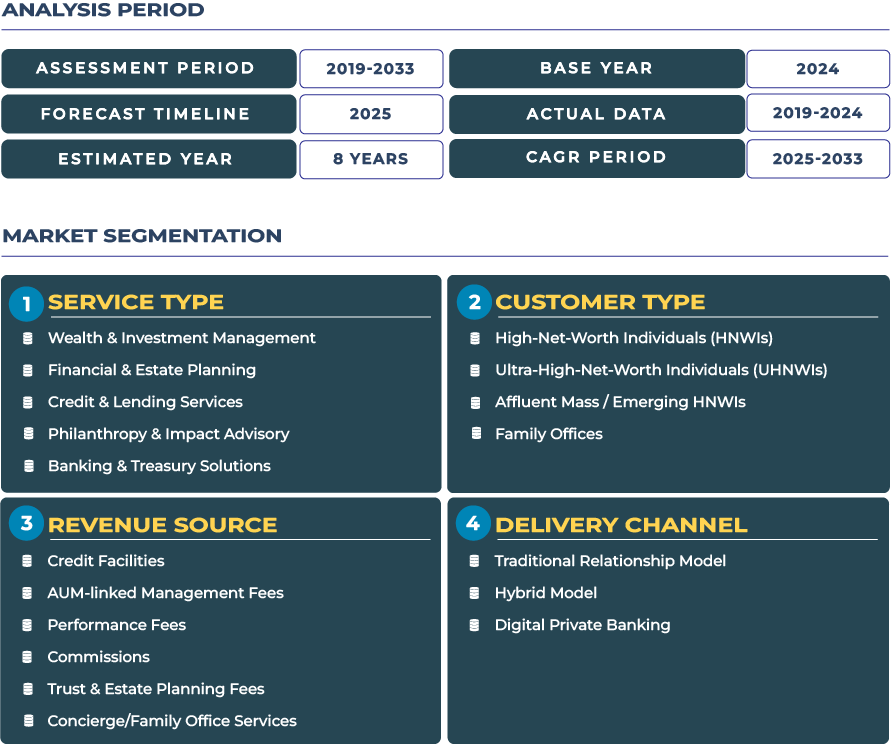Market Outlook: Strategic Growth Roadmap for the BRICS Private Banking Ecosystem to 2033
Looking ahead, the BRICS private banking market is one of incremental scale with structural maturation. From approximately USD 114.7 billion in 2025 to an estimated USD 157.7 billion in 2033, the implied 4.1% CAGR reflects both opportunity and the structural complexity of operating across emerging-market wealth ecosystems. Growth is not solely about size-but also about depth: private banks in BRICS markets must elevate their advisory models, upgrade digital wealth platforms, integrate multi-jurisdictional treasury/credit capability, and service families whose wealth transcends national borders.
Note:* The market size refers to the total revenue generated by banks through various services.
The expansion of the market is underpinned by several macro-tailwinds: increasing intra-BRICS trade and capital flows, growing entrepreneurship and SME exit activity, rising family-office penetration, and evolving client expectations for digital access and global investment reach. At the same time, the broader political and regulatory environment presents headwinds-ranging from currency exposure in Russia and South Africa, to regulatory opacity in India and Brazil, and heightened geopolitical risk in China-Russia and global trade dynamics. Capturing the projected growth therefore demands private banking firms that are both agile and resilient-capable of scaling digital platforms while navigating complex wealth, tax and mobility issues across the BRICS universe.
Drivers of Expansion & Structural Constraints: Internal Dynamics Shaping the BRICS Private Banking Sector
The BRICS private banking market is supported by several strong catalysts. First, wealth generation is accelerating across these economies-China and India have witnessed dramatic increases in HNWI counts and investable wealth. For instance, the BRICS Wealth Report shows that private-wealth growth in China soared by 92% over the past decade. Second, financial liberalisation, particularly in India and Brazil, is enabling private banks to introduce more sophisticated wealth-structuring services and credit/treasury solutions, enabling clients to diversify globally. Third, regional economic cooperation among BRICS countries is deepening, offering wealth-managers the chance to service cross-border capital flows, intra-BRICS investment corridors and global mobility solutions.
On the flip side, the BRICS private banking ecosystem faces meaningful headwinds. Political risk remains elevated in several member states: for instance, sanctions and capital-mobility restrictions in Russia constrain global advisory capability; currency volatility in South Africa and Brazil threatens asset-value stability; and regulatory ambiguity in China and India complicates private banking service expansion. Additionally, talent shortages in wealth-advisory roles and limited scale of ultra-high-net-worth (UHNW) populations in some markets restrain fee base expansion. These structural factors temper the pace of growth and underscore why the CAGR is moderate rather than explosive.
Trend-Vectors & Opportunity Frameworks: Digital Platforms, Cross-Border Wealth Corridors and Fintech Integration Driving the BRICS Private Banking Market
In the BRICS private banking market, several trend-vectors are converging. Digital wealth platforms are rapidly evolving-banks are rolling out robo-advisory, mobile wealth dashboards, integrated payments/treasury and AI-enabled portfolio tools to cater to younger, globally-oriented affluent clients. Cross-border wealth corridors are also gaining importance as capitals like Shenzhen, Bengaluru and São Paulo become nodes for investment mobility and family-office activity. Another trend is the expansion of alternative-asset advisory-with private banks in BRICS markets increasingly offering private equity, real-asset and infrastructure-linked wealth solutions to address clients’ desire for diversification beyond traditional public markets.
Looking ahead, private banking firms in the BRICS region should prioritise developing intra-BRICS wealth-corridor services that enable clients to invest and transfer wealth seamlessly between member states through integrated advisory and treasury infrastructure. Embracing digital asset and fintech integration, including tokenised assets, blockchain-enabled custody, and embedded wealth and treasury workflows, will further enhance differentiation. Additionally, infrastructure-backed investment advisory represents a major opportunity, as the region’s significant infrastructure spending allows private banks to design services linked to real-asset exposure, local credit provision, and long-term wealth planning. Firms that capitalise on these frameworks will be well positioned to capture a disproportionate share of the region’s projected growth.
Competitive Landscape: Strategic Alignments and Platform-Orchestration in the BRICS Private Banking Industry
The competitive dynamics within the BRICS private banking market are evolving from product-centric competition to platform orchestration and regional service networks. A leading institution, ICICI Bank Private Banking (India), is scaling its regional advisory footprint for wealthy clients, emphasising cross-border investment access and digital advisory platforms. Private banks across Brazil, China and South Africa are likewise pursuing strategies including segmentation, digital platform deployment, and regional ecosystem partnerships. Winning firms will be those that seamlessly integrate wealth & investment management, estate & legacy planning, credit & lending services, philanthropy & advisory and banking & treasury into unified, scalable platforms across multiple BRICS jurisdictions.








